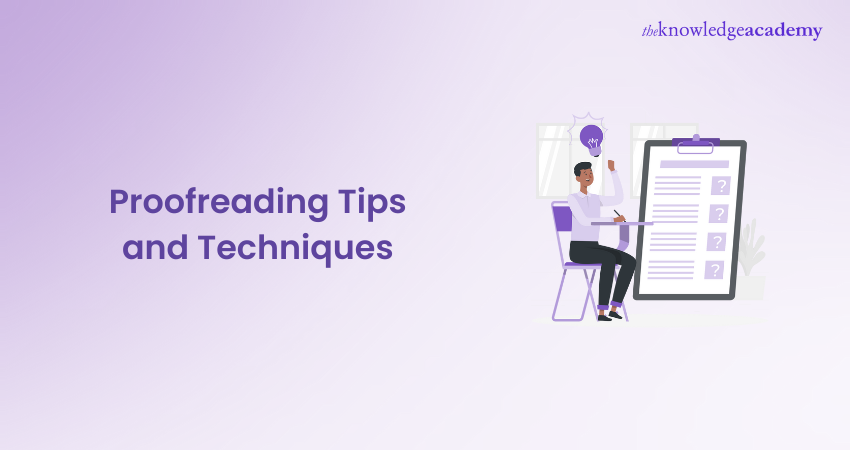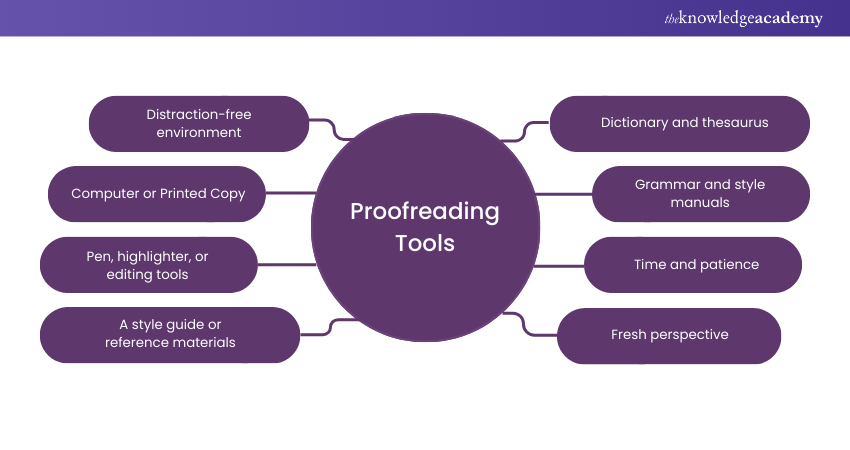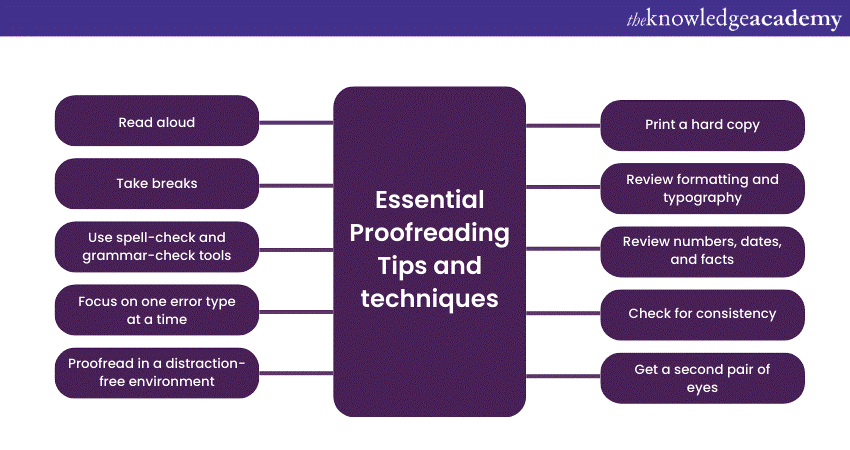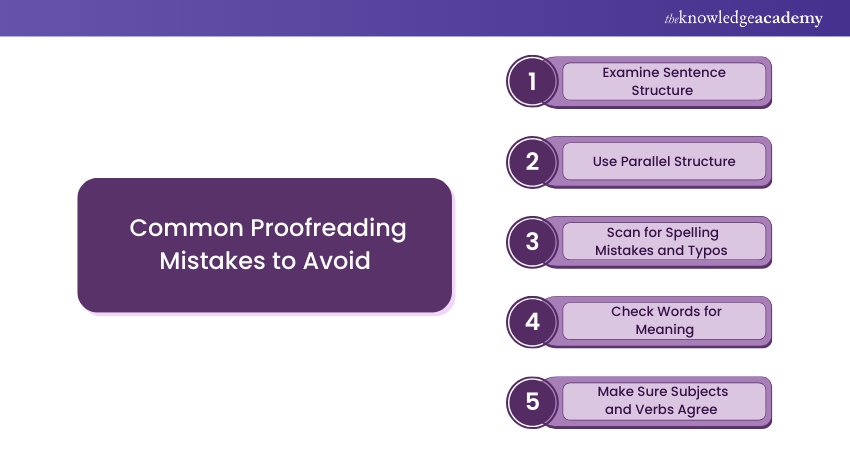We may not have the course you’re looking for. If you enquire or give us a call on 01344 203999 and speak to our training experts, we may still be able to help with your training requirements.
Training Outcomes Within Your Budget!
We ensure quality, budget-alignment, and timely delivery by our expert instructors.

Imagine crafting written works that shine with clarity and precision. What if you could transform your drafts into polished pieces that captivate readers? This is where Proofreading Tips and Techniques steps in, a crucial skill every writer should master. Proper proofreading ensures your message is clear and free from distractions. It elevates your writing, making it not just correct but compelling.
In this blog, we’ll delve deep into the essential Proofreading Tips and Techniques that every writer needs to know. Whether you’re a seasoned professional or just starting out, these strategies will help you catch those pesky errors that can detract from your work’s quality. So, grab your red pen and let’s enhance your writing together! Ready to dive into the world of proofreading? Let’s get started!
Table of Contents
1) Understanding the Proofreading Process
2) Things Required for Effective Proofreading
3) Essential Proofreading Tips and Techniques
4) Common Proofreading Mistakes to Avoid
5) Conclusion
Understanding the Proofreading Process
The proofreading process is a crucial step in producing high-quality written content, ensuring that your work is polished and professional. Proofreading involves a meticulous review of a document to identify and correct errors in spelling, grammar, punctuation, and formatting.
Unlike editing, which focuses on enhancing the overall structure, style, and clarity of writing, proofreading is concerned with correcting specific errors in the text. Effective proofreading often requires multiple readings, with each pass concentrating on different aspects of the document.
During proofreading, it is essential to check for any spelling and grammar errors, ensuring that the text adheres to the rules of the English language. Additionally, punctuation marks should be reviewed for correct usage.
Consistency is key—verify that spelling, capitalisation, and formatting are uniform throughout the document. Formatting and typography should also be examined to ensure that font styles, sizes, headings, and the overall visual presentation are consistent.
Accuracy is another critical component of proofreading. It is important to verify the accuracy of any facts, figures, and references mentioned in the writing. To improve the readability and flow of the content, address any awkward sentence structures or ambiguous statements. Finally, conduct a comprehensive review of the entire document to catch any remaining errors or inconsistencies, ensuring the highest level of quality in your written work.

Things Required for Effective Proofreading
To proofread effectively, ensure you have the following:

a) Distraction-free environment: Find a quiet space where you can concentrate without interruptions.
b) Computer or printed copy: Access the document either on your computer or in printed form for review.
c) Pen, highlighter, or editing tools: Use these tools to mark errors, make corrections, or highlight areas that need revision.
d) A style guide or reference materials: Keep a style guide or reference materials handy for consistency in grammar, punctuation, and formatting.
e) Dictionary and thesaurus: Refer to a dictionary and thesaurus to clarify word meanings, spellings, and find synonyms or antonyms.
f) Grammar and style manuals: Use grammar and style manuals for guidance on proper usage and conventions.
g) Time and patience: Allocate dedicated time, approaching it patiently and thoroughly.
h) Fresh perspective: Whenever possible, proofread with a fresh set of eyes by taking breaks between writing and Proofreading.
Ready to polish your writing? Register for our Proofreading Course and make every word count!
Essential Proofreading Tips and Techniques
Effective Proofreading is essential for ensuring the accuracy and quality of your written content. By implementing the following best Proofreading Tips and Techniques, you can enhance your skills and produce polished and error-free writing:

a) Read aloud: One of the most effective Proofreading and editing tips is to read the content aloud. This technique helps you identify awkward sentence structures, missing words, or grammatical errors that may not be apparent when reading silently. Hearing the words spoken aloud provides a different perspective and can reveal errors that might have been overlooked.
b) Take breaks: Taking breaks between sessions is crucial. It allows you to approach the document with a fresh perspective, reducing the chances of overlooking errors. Stepping away from the text for a while and returning to it later helps you spot mistakes more easily.
c) Use spell-check and grammar-check tools: Utilise spell-check and grammar-check tools available in word processing software. These tools can catch basic errors and provide suggestions for corrections. However, keep in mind that they are not foolproof and should be used as a starting point rather than relying solely on them. Manual Proofreading is still necessary to ensure accuracy.
d) Focus on one error type at a time: To maintain focus and improve efficiency, concentrate on one type of error at a time. For example, first, review the document for spelling errors, then move on to grammar, punctuation, consistency, and formatting. By tackling one aspect at a time, you can give it your full attention and minimise the chances of missing errors.
e) Proofread in a distraction-free environment: Create a distraction-free environment when Proofreading. Find a quiet space where you can concentrate without interruptions. Minimise distractions such as background noise, phone notifications, or other tasks that can divert your attention from the process. A focused environment will help you maintain accuracy and efficiency.
To get a deeper understanding of Proof reading and its types, refer our blog ob "Types of Proofreading"
f) Print a hard copy: If possible, print a hard copy of the document. Reading a physical copy allows you to see the text from a different perspective and often helps in spotting errors that might have been missed on a screen. Use a pen or highlighter to mark the corrections directly on the paper.
g) Review formatting and typography: One of the key Proofreading Tips and Techniques is to pay attention to formatting and typography while proofreading. Check for consistency in font styles, sizes, headings, and spacing. Ensure proper indentation, alignment, and use of bullet points or numbered lists where necessary. Consistent formatting enhances the visual appeal and professionalism of your writing.
h) Review numbers, dates, and facts: Carefully check all numbers, dates, and factual information mentioned in your writing. Verify the accuracy of statistics, figures, and any specific details provided. Ensure that dates, addresses, and other relevant information are correct and consistent throughout the document.
i) Check for consistency: Consistency is crucial in maintaining the flow and professionalism of your writing. Pay attention to consistent spelling, capitalisation, and punctuation. Ensure that abbreviations and acronyms are consistently used throughout the document. Consistency contributes to clarity and readability.
j) Get a second pair of eyes: Consider asking a friend or associate to review your work. Fresh eyes can spot errors that you might have missed due to familiarity with the content. Another person's perspective can provide valuable feedback and help improve the quality of your writing.
Master the art of attention management and reclaim control of your time with our transformative Attention Management Training Course!
Common Proofreading Mistakes to Avoid
Proofreading is a vital step in ensuring your writing is polished and professional. However, common mistakes can easily slip through the cracks if you're not careful. This section highlights key areas to focus on during proofreading to help you avoid common errors and produce clear, error-free content.

1) Examine Sentence Structure
One of the most frequent proofreading mistakes is overlooking sentence structure. Ensure that your sentences are clear, concise, and correctly arranged. Poorly constructed sentences can confuse readers and disrupt the flow of your writing. Check for run-on sentences, fragments, and awkward phrasing to maintain clarity and readability.
2) Use Parallel Structure
Parallel structure, or parallelism, involves using the same pattern of words or phrases in a sentence or a list. Maintaining parallelism enhances the readability and rhythm of your writing. Avoid mistakes like mixing different verb forms or inconsistent list formats, as they can make your content seem disjointed and less professional.
3) Scan for Spelling Mistakes and Typos
Spelling mistakes and typos are among the easiest errors to miss during proofreading. These small errors can significantly undermine the credibility of your writing. Take the time to carefully scan your content for any spelling errors or typographical mistakes and consider using both manual review and spellcheck tools for thoroughness.
4) Check Words for Meaning
Words that sound similar but have different meanings (homophones) can easily be misused in writing. Always double-check words for their correct meaning to ensure your message is clear. Confusing words like "affect" and "effect" or "complement" and "compliment" can change the intended meaning of a sentence, so careful review is essential.
5) Make Sure Subjects and Verbs Agree
Subject-verb agreement is a fundamental aspect of grammar that should never be overlooked. Ensure that your subjects and verbs agree in number, meaning singular subjects take singular verbs and plural subjects take plural verbs. This basic grammar rule is crucial for maintaining the correctness and professionalism of your writing.
Conclusion
Mastering Proofreading Tips and Techniques not only elevates your writing but also transforms good content into truly exceptional work. Proofreading is your final opportunity to catch those small details that make a big difference—it's the finishing touch that brings your content to life. So, embrace the power of precision and let it guide you toward creating flawless, compelling writing that leaves a lasting impression.
Ignite your personal development journey with our comprehensive Personal Development Course and unlock your true potential today!
Frequently Asked Questions

Proofreading primarily focuses on correcting spelling, grammar, and punctuation errors, ensuring consistency in formatting, and improving clarity and readability to produce polished, error-free content.

A proofreader needs a strong grasp of grammar rules, attention to detail, familiarity with style guides, and the ability to spot inconsistencies in formatting and language usage to ensure the accuracy and quality of written content.

The Knowledge Academy takes global learning to new heights, offering over 30,000 online courses across 490+ locations in 220 countries. This expansive reach ensures accessibility and convenience for learners worldwide.
Alongside our diverse Online Course Catalogue, encompassing 19 major categories, we go the extra mile by providing a plethora of free educational Online Resources like News updates, Blogs, videos, webinars, and interview questions. Tailoring learning experiences further, professionals can maximise value with customisable Course Bundles of TKA.

The Knowledge Academy’s Knowledge Pass, a prepaid voucher, adds another layer of flexibility, allowing course bookings over a 12-month period. Join us on a journey where education knows no bounds.

The Knowledge Academy offers various Personal Development Courses, including the Creative Writing Course, and the Report Writing Course. These courses cater to different skill levels, providing comprehensive insights into Why is Proofreading Important.
Our Business Skills Blogs cover a range of topics related to Personal Development, offering valuable resources, best practices, and industry insights. Whether you are a beginner or looking to advance your Business skills, The Knowledge Academy's diverse courses and informative blogs have got you covered.
Upcoming Business Skills Resources Batches & Dates
Date
 Proofreading Course
Proofreading Course
Fri 14th Feb 2025
Fri 11th Apr 2025
Fri 13th Jun 2025
Fri 15th Aug 2025
Fri 10th Oct 2025
Fri 12th Dec 2025







 Top Rated Course
Top Rated Course


 If you wish to make any changes to your course, please
If you wish to make any changes to your course, please


